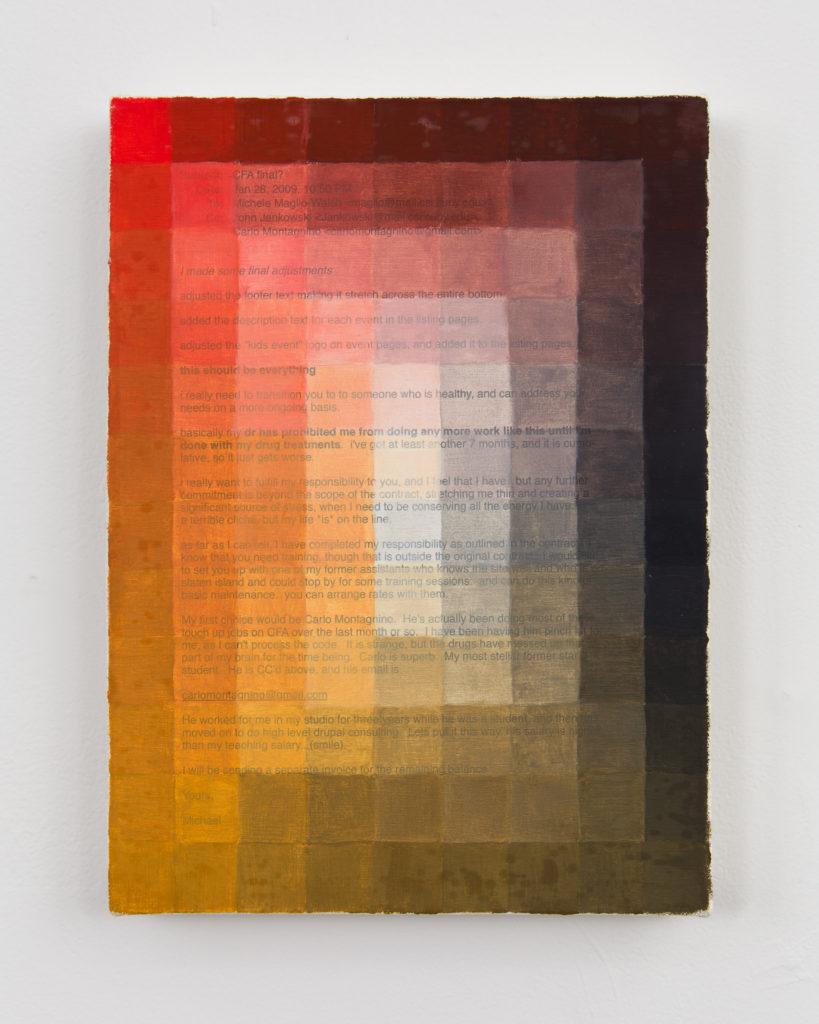When an Artist’s Body Breaks Down Human Relations Become Crucial
Michael Mandiberg’s Timeframe exhibition gives the viewer a window into a period of time when they had to deal with the breakdown of their own body.
by Seph Rodney
December 22, 2021

Michael Mandiberg, “My doctor has prohibited me from doing any more work”(Zorn Palette) (2020) oil and inkjet on canvas 12 x 9 inches
There is a way in which the human body functions like a machine, and the artist or their entire studio operation also easily slot into this machinist metaphor. And like many systems in the world, their inner workings become the subjects of intense scrutiny, study, and appreciation when they break down. Michael Mandiberg’s Timeframe exhibition gives the viewer a window into a period of time when the artist had to deal with the breakdown of their own body due to a bout with aggressive cancer, and this window allows me to see the inner workings of their studio and the lively and supportive relationships with their assistants.
 Installation view of Timeframe at Denny Dimin gallery
Installation view of Timeframe at Denny Dimin gallery
Having written about Mandiberg’s work before I can attest to it tending to be rather high concept. Their penchant for that is evident here, as is their inclination to use a digital vocabulary and digital tools. Timeframe is actually a summary of two much larger bodies of work — Zoom Paintings (which I will leave aside) and portraits produced for Live Study, a durational performance which includes an archive of live-streamed video documenting the artist’s painting sessions, and a series of oil portraits and related color studies. The paintings here do several things at once. They are representative of Mandiberg teaching themselves to paint. They serve to document the various projects, commissions, and responsibilities taken on and the workflows generated in their fulfillment. They also account for the underlying humanity that undergirds Mandiberg’s whole art making enterprise. In one painting titled, “My doctor has prohibited me from doing any more work (Zorn Palette)” (2020), the image is a color gradient wafting out from a white center into washes of red and yellow, underneath which is the text of an email exchanged with the studio worker Michele Maglio-Walsh. The text reads in part:
I really need to transition you to someone who is healthy and can address your needs on a more ongoing basis. Basically my dr has prohibited me from doing any more work like this until I’m done with my drug treatments. I’ve got at least another 7 months, and it is cumulative, so it just gets worse.
It’s the sense of Mandiberg’s responsibility to the people they work with that permeates the show, through the combination of semi-naïve portraits, spreadsheets, digitized gradients, and video stills with email correspondence that includes recommendation letters and letters seeking to secure fellowships with the artist.
 Installation view of Timeframe at Denny Dimin gallery
Installation view of Timeframe at Denny Dimin gallery
It’s the people and the gossamer threads of loyalty, duty, affection, and care that connect us to each other that become palpable here and are the most touching aspects of this show. The art scene that I know certainly consists of cutthroat gallery and studio systems which ruthlessly exploit artists, but Mandiberg’s memorialization of the people who worked with them to keep making art at their most physically vulnerable state brings something else to the surface. We are responsible for each other — at least if we choose to be.
Timeframe continues at Denny Dimin gallery (39 Lispenard Street, Tribeca, Manhattan) through December 23.
Read on Hperallergic.
